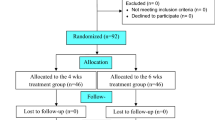Summary
An account is given of the use of cephacetrile in the treatment of 49 children, aged 1 month to 9 years, who were suffering from pertussis with bronchial or pulmonary complications of mixed bacterial origin. The dosage of cephacetrile averaged 58.7–87.4 mg/kg daily. In the first phase of the study, the therapeutic activity of the drug was evaluated using various criteria including clinical evidence, laboratory tests, and radiological findings, and according to the global assessment based on the results of these studies, cephacetrile was significantly more effective than cephaloridine (p<0.05). The systemic tolerability of cephacetrile, which was examined in both phases of the trial, proved excellent; the local tolerability of the drug was likewise found to be exceptionally good, even although the concentration of lidocaine in the solvent employed for the intramuscular doses was particularly low (0.5%).
Zusammenfassung
Es wird berichtet über die Therapie mit Cephacetril bei 49 Kindern im Alter von 1 Monat bis 9 Jahren, welche an Keuchhusten mit bronchialen und pulmonalen Komplikationen gemischten bakteriellen Ursprungs erkrankt waren. Die Dosierung von Cephacetril betrug durchschnittlich 58,7–87,4 mg/kg/die. Hinsichtlich der im ersten Teil der Studie untersuchten therapeutischen Wirksamkeit, bewertet anhand von klinischem Befund, Laboruntersuchungen und radiologischem Befund, erwies sich in einer Gesamtbeurteilung Cephacetril gegenüber Cephaloridin als signifikant wirksamer [p<0,05]. Die im ersten und zweiten Teil der Studie untersuchte allgemeine Verträglichkeit von Cephacetril stellte sich als vorzüglich und die lokale Verträglichkeit als außerordentlich gut heraus, selbst wenn für die i. m. Applikation Lösungsmittel mit einer besonders niedrigen Lidocain-Konzentration (0,5%) verwendet wurden.
Similar content being viewed by others
Literature
Knüsel, F., Konopka, E. A., Gelzer, J., Rosselet, A.: Antimicrobial studies in vitro with CIBA 36278-Ba, a new cephalosporin derivative. Antimicrob. Agents Chemother. (1970) 140–149.
Kradolfer, F., Sackmann, W., Zak, O., Brunner, H., Hess, R., Konopka, E. A., Gelzer, J.: CIBA 36278-Ba: Chemotherapy and toxicology in laboratory animals. Antimicrob. Agents Chemother. (1970) 150–155.
Mioli, V., Vangelista, A., Albertazzi, A., Bortolotti, G. C., Bonomini, V. Renal effects of CIBA 36278-Ba in man, in healthy and diseased subjects. In: Advances in Antimicrobial and Antineoplastic Chemotherapy. Proceedings of the 7th International Congress of Chemotherapy, Prague 1971, S. 487–488. Urban & Schwarzenberg, Munich 1972.
Spring, P., Räber, J., Reber, H., Dettli, L. Die Elimination des Antibiotikums Cephacetril bei Patienten mit eingeschränkter Nierenfunktion. Schweiz. med. Wschr. 103 (1973) 783–788.
Author information
Authors and Affiliations
Rights and permissions
About this article
Cite this article
di Nola, F., Soranzo, M.L. Clinical trials with cephacetrile in the treatment of secondary respiratory infections in childhood pertussis. Infection 4 (Suppl 3), S220–S222 (1976). https://doi.org/10.1007/BF01781046
Issue Date:
DOI: https://doi.org/10.1007/BF01781046




